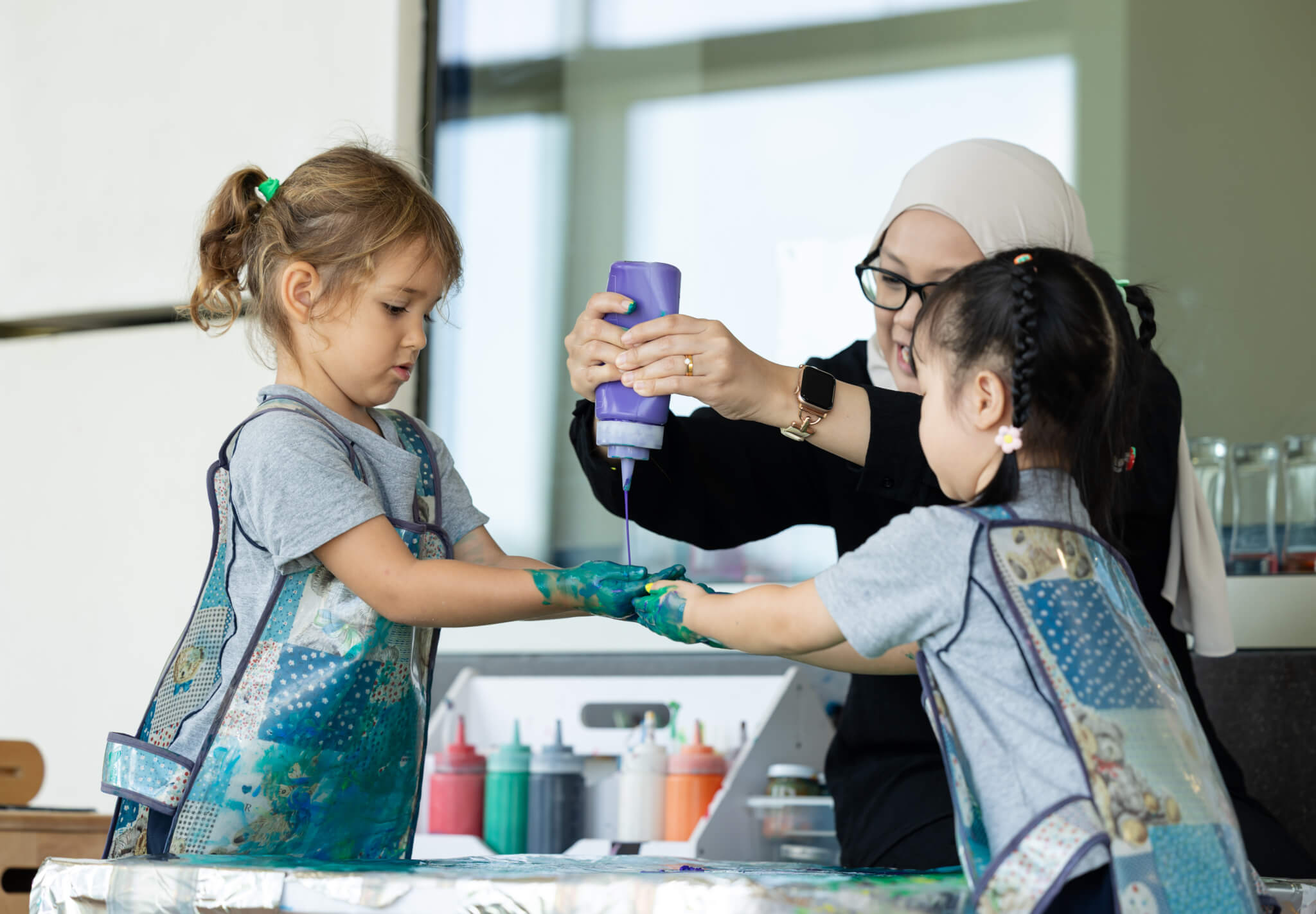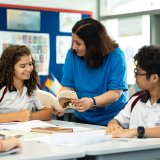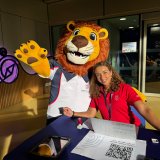Preschool is a time for exploration, creativity, and growth. In schools that follow science-based teaching methods, these elements are emphasized as essential to nurturing confident, capable individuals.
Instead of focusing solely on academic milestones, modern preschools provide a safe, supportive environment where children engage in hands-on projects, collaborate with peers, and explore new ideas at a pace suited to their developmental stage. This approach fosters critical early skills—such as communication, problem-solving, and literacy—that lay the groundwork for future self-motivation and leadership. Let’s take a closer look at how these nurturing environments help support children’s developmental goals.
Summary of Contents:
Creating a Nurturing Environment for Preschoolers
- Emotional Security as the Foundation for Future Learning
- Learning Through Exploration
- Integrating Social and Emotional Learning (SEL)
- Highly Skilled Educators Make the Difference
- Outdoor Play as a Learning Opportunity
- What to Look For in a Preschool
- Warm, Respectful Relationships
- Thoughtfully Designed Environment
- Integrated SEL
- Regular Outdoor Access
- Clear, Transparent Progress TrackingWhat to Look For in a Preschool
- What Sets Stamford American’s Early Learning Village Apart?
- Specialist Teacher Program
- Gold Student Standards
- Bilingual Program with One-Teacher Model
8. Discover How Stamford American Nurtures Every Child’s Potential
Emotional Security as the Foundation for Future Learning
What truly makes a learning environment nurturing and inclusive in early childhood? It begins with recognizing that mistakes are a natural part of learning—not something to be punished or discouraged. Rather than devaluing children for getting things wrong, effective early education fosters emotional security, creating a space where curiosity, self-expression, and problem-solving are encouraged. This sense of safety is essential for children to develop a positive, resilient approach to learning that will serve them for life.
This is why emotional safety is a vital component of a nurturing preschool environment. Since every child is unique, educators must take a responsive approach—adapting routines and setting personalized boundaries that protect and support each child’s individual learning journey. Over time, this consistent, thoughtful care helps children build the confidence to ask questions, take risks, and grow both emotionally and academically.
Learning through Exploration
When preschoolers feel safe and supported, exploration and learning unfold naturally. This principle lies at the heart of the Reggio-inspired approach—a globally respected philosophy in early experiential education.
In Singapore, many high-quality early childhood programs draw inspiration from Reggio Emilia, tapping into children’s innate curiosity to foster a lifelong love of learning. Instead of directing what children should think or say, educators observe attentively, pose thoughtful, age-appropriate questions, and provide open-ended materials that encourage discovery, experimentation, and meaningful engagement.
Unlike the rigid lesson plans typical of many mainstream programs, Reggio-inspired curricula evolve organically from children’s own interests. This child-led approach keeps young learners deeply engaged during their formative years, laying a strong foundation for creativity, critical thinking, and problem-solving—skills essential for becoming thoughtful, responsible global citizens. Just as importantly, it validates children as capable thinkers and active participants in their learning, empowering them to grow into confident leaders, should they choose that path.
Integrating Social and Emotional Learning (SEL)
In strong preschool environments, social-emotional development isn’t treated as secondary to academics—it’s an integral part of daily life. These programs intentionally embed Social and Emotional Learning (SEL) into everyday routines, helping children recognize their emotions and develop a healthy sense of self. By fostering emotional awareness and empathy, SEL also equips young learners to collaborate effectively and navigate conflicts constructively.
This holistic approach to early education goes beyond cultivating academic success—it lays the groundwork for lifelong interpersonal growth. Through SEL, children develop self-awareness, empathy, and practical strategies for managing everyday frustrations and anxieties. In the most effective preschools, SEL isn’t seen as a luxury or add-on; it’s recognized as essential to helping children grow into well-rounded, resilient individuals.
Highly Skilled Educators Make the Difference
Approaches like Reggio Emilia and SEL rely heavily on skilled educators who can thoughtfully guide, observe, and support children through each stage of early development. Creating an emotionally safe and intellectually stimulating environment requires teachers who are trained to recognize developmental milestones and tailor their strategies to meet the unique needs of every child.
Effective preschool teachers also recognize the crucial role that the home environment plays in a child’s development. They actively engage with parents, sharing strategies that support continued learning beyond the classroom. This collaboration creates a sense of continuity between school and home, reinforcing children’s curiosity and helping to nurture a lasting love of learning.
Outdoor Play as a Learning Opportunity
While classroom environments offer valuable structure, they can’t fully capture the range of experiences young children need. Regular outdoor play expands the boundaries of learning, reinforcing the idea that discovery isn’t confined to the classroom. These open-ended, nature-based experiences help children see that learning can happen anywhere—through exploration, movement, and connection with the world around them.
Importantly, outdoor environments offer unique learning opportunities that indoor classrooms can’t fully replicate. Whether children are climbing small hills, building sandcastles, or simply moving freely, outdoor play fosters physical coordination, confidence, and creativity—skills that support success across all areas of life. Structured time outdoors also promotes emotional regulation, teamwork, and problem-solving, making it an essential component of any well-rounded preschool curriculum.
What to Look For in a Preschool
Choosing a preschool is about finding an environment that supports your child’s developmental needs and aligns with your family’s values. Here are a few practical factors to consider when evaluating your options:
- Warm, respectful relationships: Do teachers interact with children in a kind, respectful, and emotionally supportive way?
- Thoughtfully designed environment: Are there safe, inviting spaces for creative play, quiet reading, and hands-on exploration?
- Integrated social-emotional learning (SEL): Does the curriculum intentionally promote empathy, cooperation, and emotional self-regulation?
- Regular outdoor access: How frequently do children spend time outside, and how is outdoor space used to enhance learning and play?
- Clear, transparent progress tracking: How does the school assess each child’s development, and how is this progress shared with parents?
This starter’s guide to preschool education in Singapore may offer more helpful insights for families navigating the early learning landscape.
What Sets Stamford American’s Early Learning Village Apart?
Stamford American International School’s Early Learning Village (ELV) is designed specifically for children aged 18 months to 6 years, encompassing Pre-Nursery and Nursery, Pre-Kindergarten, Kindergarten 1, and Kindergarten 2. From its thoughtfully crafted curriculum to its specialized learning spaces, every aspect of the ELV experience is carefully designed to provide an ideal learning environment for preschoolers, fostering the development of the whole child.
Here’s what makes the Early Learning Village truly special:
- Specialist Teacher Program
Stamford American’s Early Learning Village offers a rich educational experience through its Specialist Teacher Program, with daily sessions led by experts in their fields. These sessions enhance each child’s development across a range of disciplines:
- Music: Using the world-renowned Suzuki method, children are introduced to the violin and cello, fostering focus, discipline, and a love for music.
- Art: The Design Art Program for KG1 and KG2 encourages creative exploration and builds artistic confidence during these critical early years.
- Physical Education: The Smart Moves Perceptual Motor Program supports physical development and strengthens the body-brain connection through purposeful movement.
- Languages: All students participate in daily language classes—Mandarin, Spanish, or English as an Additional Language (EAL)—laying the foundation for multilingual fluency and cultural appreciation.
- Library and Literacy: Weekly library sessions from Pre-N to KG2 and the use of structured literacy programs such as Heggerty (Pre-K, KG1) and UFLI (KG2) support foundational literacy.
- Inquiry-Based and STEAMInn Homeroom Enhancements
Daily inquiry-based learning and STEAMInn activities, which integrate Science, Technology, Engineering, Arts, Mathematics, and Innovation, enhance the homeroom experience, supporting design thinking, experimentation, and early innovation aligned with the Next Generation Science Standards (NGSS) introduced in KG2.
- Gold Student Standards
Stamford American uses the Teaching Strategies GOLD framework to monitor and track each child’s developmental progress. Teachers assess key milestones across various domains and provide detailed reports on children’s growth every quarter. This ensures transparent, personalized support, fostering a learning environment where each child’s individual needs are met.
Assessments cover multiple areas including math, literacy, language, and social-emotional development, and differentiated instruction ensures all learners are appropriately challenged.
- Bilingual Program with One-Teacher Model
At the Early Learning Village, students benefit from a one-teacher language immersion model, where bilingual learning is seamlessly woven into the daily routine. This approach takes full advantage of young children’s natural ability to absorb language, while providing the consistency and emotional security that come from learning with a single, trusted educator. The result is a deeply enriching and intuitive multilingual experience that supports both cognitive and emotional development. Beginning in Pre-K, a translanguaging approach is used to build bilingual proficiency while maintaining academic rigor.
Discover How Stamford American Nurtures Every Child’s Potential
If you’re seeking a safe, supportive preschool environment that builds strong foundations while honoring your child’s individuality, Stamford American’s Early Learning Village (ELV) offers a place where young learners can truly thrive. With purpose-built facilities, passionate educators, and a holistic approach to early education, the ELV is thoughtfully designed to support every aspect of your child’s development.
Reach out to our admissions team to learn more about our programs or schedule a personalized visit. You can also take a virtual tour of the ELV’s facilities. We’d be delighted to welcome your family into our community.
Tips on How to Deal with Your Anxieties as a Parent
It’s not just children who need preparation—parents also play a crucial role in ensuring a smooth transition. It’s natural to feel nervous when watching your child take on something new for the first time. Here are some tips to help you manage your emotions and effectively support your child during this important milestone:
- Stay Informed
Familiarize yourself with the kindergarten’s policies, curriculum, and daily schedule. Utilize the school’s parent care program or online portal to gather important information. Being well-informed not only boosts your confidence but also enables you to answer your child’s questions accurately. Attend parent briefings and engage with teachers to learn how you can best support your child’s learning journey.
- Manage Your Anxiety
It’s natural to feel nervous about your child starting school, but it’s important to manage these emotions. Remember, your child can sense your anxiety, and if you feel overwhelmed, they might become uneasy about the transition. Practice relaxation techniques like deep breathing, or seek support from other parents. Remind yourself that starting kindergarten is a positive milestone in your child’s growth and development.
- Be Practical with Your Preparation
Get your child’s school supplies, uniform, and any required documents ready ahead of time. Being organized helps minimize last-minute stress and provides peace of mind. Label your child’s belongings and teach them how to recognize their items to prevent mix-ups with classmates’ possessions.
- Trust the Teachers
Trust the kindergarten staff to care for your child. Experienced and qualified teachers are skilled at helping young children feel comfortable and supported. While it can be difficult to let go of control, trusting the professionals will help ease your anxiety as you see your child thrive in their care.
- Set Realistic Expectations
Be prepared for the transition to take time. It’s normal for children to feel nervous or shed a few tears in the first days. Stay patient and supportive, and remember to celebrate small milestones as your child adjusts to their new routine.
- Build a Support Network
Connect with other parents whose children are attending the same kindergarten. Sharing experiences and advice can help you feel more supported and less isolated. A strong network provides a space to discuss concerns and exchange useful tips.
By preparing both yourself and your child for this new chapter, you’ll make the transition to kindergarten a positive and rewarding experience for the whole family.
Stamford American International School’s Premier Early Childhood Education Program in Singapore
Stamford American International School offers early childhood education programs designed to give young learners a solid foundation for life. Our classes cater to children from 2 months to 6 years old, housed in our thoughtfully designed Early Learning Village in Chuan Lane. The campus features six outdoor play zones, a covered pool, an indoor air-conditioned gymnasium, specialist classrooms, and a clinic. The collaborative spaces and age-appropriate learning zones support holistic development.
The Village reflects a nurturing, child-centered philosophy that promotes curiosity, creativity, and exploration. The school is Reggio-inspired, which encourages children to engage actively with their environment through hands-on, meaningful learning experiences. This philosophy is paired with Stamford’s bilingual education framework, where preschool-aged children gain proficiency in both English and Mandarin, laying a strong foundation for cognitive and linguistic growth.
For parents seeking a globally minded and exceptional preschool experience, Stamford American provides an unparalleled environment where children can thrive and build a strong foundation for future success. Get in touch with us today or schedule a tour of our campus to learn more.






